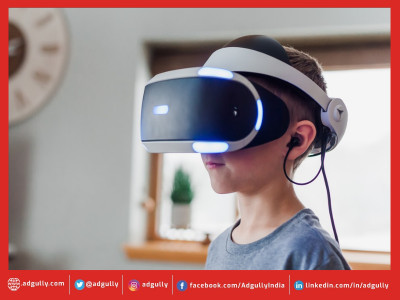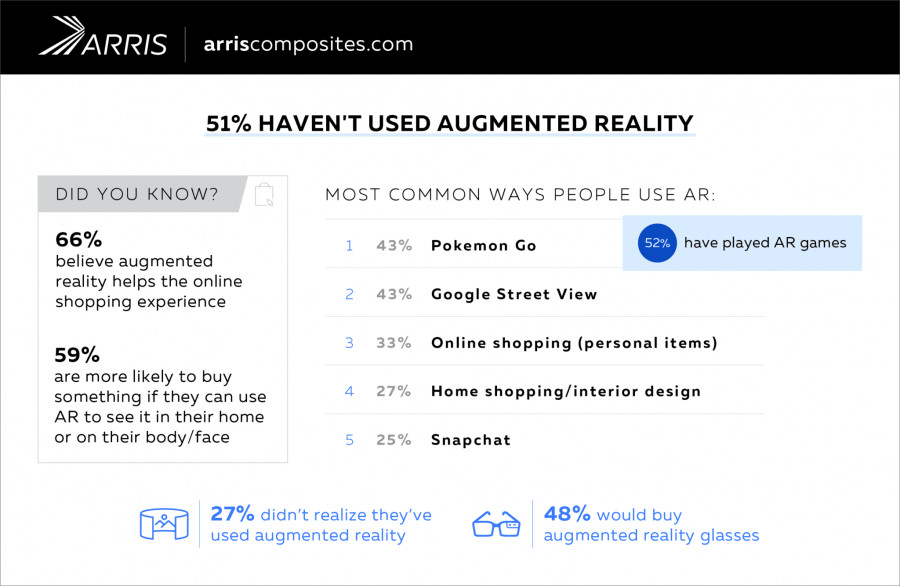More than 79% Americans interested in VR headsets: Report
Technology is ever-changing, and one area that is rapidly growing right now is virtual and augmented reality. Here at ARRIS, we work with companies who strive to make portable electronic devices smaller, thinner, lighter, tougher, and more sustainable, including VR headsets. As attention and use of these technologies continue to grow, we surveyed more than 1,000 Americans to learn about the consumer use of VR and AR.
Virtual Reality Use in America
Virtual reality (VR) is a three-dimensional simulated experience where the user can interact with the environment by using special equipment, like a headset or helmet. More than 3 in 4 (79%) Americans are interested in virtual reality and virtual reality headsets. In fact, nearly 1 in 5 own a VR headset.
Among VR headset owners, 92% use the technology for gaming, 29% use it to explore other places like museums, 25% watch movies and TV on their headsets, and 23% use it to work out. Other uses include meditation, chatting with friends, and flight simulation.
Users say their favorite things about VR are that it provides an immersive experience (75%) and that people are able to experience those things from the comfort of their homes (25%).
With the majority of respondents (67%) using headsets for 2 hours or less per week, 78% of those surveyed said their headset is comfortable. In fact, nearly 1 in 4 (23%) are planning on buying another headset in the next year.
But, sources say that people who use headsets for more than two hours per week may begin to feel discomfort as many VR headsets tend to be heavy. According to the FDA, some models weigh close to two pounds, and this prolonged use could cause neck fatigue, discomfort, or pain. Extended use of VR headsets can also lead to eye strain and leg or back pain, especially with applications requiring frequent eye movement or prolonged sitting or standing (FDA, 2022).
For the 71% who don’t currently own a VR headset and are not planning on purchasing one in the near future, the reasons for not wanting one vary. 67% of respondents say it’s too expensive, 33% don’t think they’d use it, and 27% are just not interested in VR.
According to FinancesOnline, an ongoing challenge in attracting more consumers to VR products is poor user experience. In fact, 26% of consumers’ VR barriers are attributed to issues such as bulky hardware and technical glitches (FinancesOnline, 2022).
Augmented Reality Use in America
Augmented reality (AR) is a technology that enhances the real physical world by adding digital visual or audio elements. 51% of people say they haven’t used augmented reality. However, after explaining the different ways AR is used in everyday life, 27% of survey respondents said they didn’t realize they actually have used the technology before.
2 in 3 believe AR helps the online shopping experience by allowing people to place things in their homes or even on their bodies to see how the items look. In fact, 59% say they are more likely to buy something if they can use AR to see it in their home or on their body.
The most common ways people have used AR are through Pokemon Go (43%), Google Street View (43%), online shopping for personal items like shoes or sunglasses (33%), home shopping or interior design (27%), and Snapchat (25%). As new technologies continue to emerge, 48% of Americans say they would buy AR glasses.
The Future of AR & VR Technologies
Whether or not people have used VR or own a headset, 57% believe VR will become a part of everyday life in the next few years. Even more people (71%) believe AR will also become part of everyday life over the next couple of years.
AR and VR aren’t only used for recreational use. In fact, 88% of people say both technologies can help improve education, and 66% believe AR and VR can help fight social isolation. It can also be used as an alternative to other activities; for example, 77% say they would consider using VR or AR to ‘travel’ to see somewhere they’ve never been.
Whether or not you own a VR headset or have an interest in either technology right now, 82% think they will use AR and VR more in the coming years, and 53% expect to buy a headset in the next three years.

















Share
Facebook
YouTube
Tweet
Twitter
LinkedIn